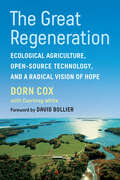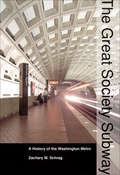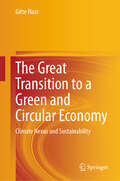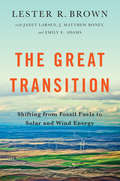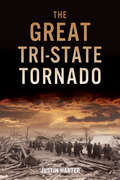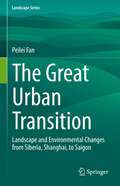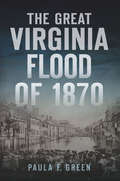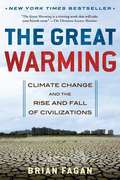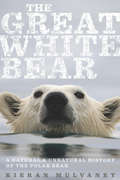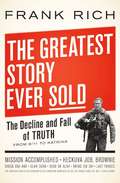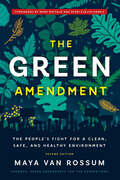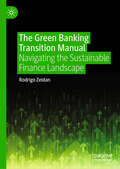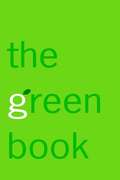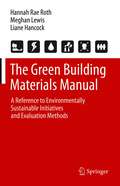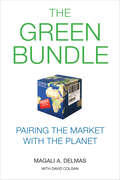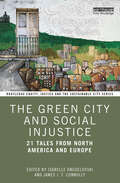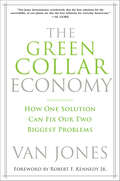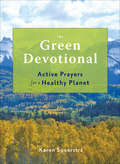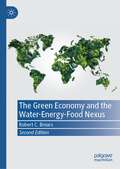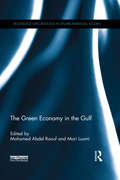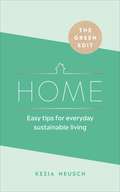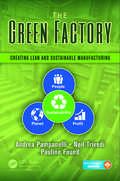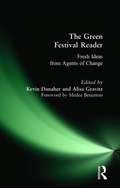- Table View
- List View
The Great Regeneration: Ecological Agriculture, Open-Source Technology, and a Radical Vision of Hope
by Dorn CoxIn the age of climate change, food scarcity, and increasing industrialization, can a few visionary farmers find global solutions through technology and create networked, open-source regenerative agriculture at a truly transformative scale?In The Great Regeneration, farmer-technologist Dorn Cox and author-activist Courtney White explore unique, groundbreaking research aimed at reclaiming the space where science and agriculture meet as a shared human endeavor. By employing the same tools used to visualize and identify the global instability in our climate and our communities—such as satellite imagery—they identify ways to accelerate regenerative solutions beyond the individual farm.The Great Regeneration also explores the critical function that open-source tech can have in promoting healthy agroecological systems, through data-sharing and networking. If these systems are brought together, there is potential to revolutionize how we manage food production around the world, decentralizing and deindustrializing the structures and governance that have long dominated the agricultural landscape, and embrace the principles of regenerative agriculture with democratized, open-source technology, disseminating high-quality information, not just to farmers and ranchers, but to all of us as we take on the role of ecosystem stewards.In this important book, the authors present a simple choice: we can allow ourselves to be dominated by new technology, or we can harness its potential and use it to understand and improve our shared environment. The solutions we need now, they write, involve a broader public narrative about our relationship to science, to each other, and to our institutions. And we all need to understand that the choices made today will affect the generations to come. The Great Regeneration shows how, together, we can create positive and lasting change.
The Great Society Subway: A History of the Washington Metro (Creating the North American Landscape)
by Zachary M. SchragAs Metro stretches to Tysons Corner and beyond, this paperback edition features a new preface from the author.Drivers in the nation's capital face a host of hazards: high-speed traffic circles, presidential motorcades, jaywalking tourists, and bewildering signs that send unsuspecting motorists from the Lincoln Memorial into suburban Virginia in less than two minutes. And parking? Don't bet on it unless you're in the fast lane of the Capital Beltway during rush hour.Little wonder, then, that so many residents and visitors rely on the Washington Metro, the 106-mile rapid transit system that serves the District of Columbia and its inner suburbs. In the first comprehensive history of the Metro, Zachary M. Schrag tells the story of the Great Society Subway from its earliest rumblings to the present day, from Arlington to College Park, Eisenhower to Marion Barry. Unlike the pre–World War II rail systems of New York, Chicago, and Philadelphia, the Metro was built at a time when most American families already owned cars, and when most American cities had dedicated themselves to freeways, not subways. Why did the nation's capital take a different path? What were the consequences of that decision?Using extensive archival research as well as oral history, Schrag argues that the Metro can be understood only in the political context from which it was born: the Great Society liberalism of the Kennedy, Johnson, and Nixon administrations. The Metro emerged from a period when Americans believed in public investments suited to the grandeur and dignity of the world's richest nation. The Metro was built not merely to move commuters, but in the words of Lyndon Johnson, to create "a place where the city of man serves not only the needs of the body and the demands of commerce but the desire for beauty and the hunger for community."Schrag scrutinizes the project from its earliest days, including general planning, routes, station architecture, funding decisions, land-use impacts, and the behavior of Metro riders. The story of the Great Society Subway sheds light on the development of metropolitan Washington, postwar urban policy, and the promises and limits of rail transit in American cities.
The Great Transition
by Bruce CampbellIn the fourteenth century the Old World witnessed a series of profound and abrupt changes in the trajectory of long-established historical trends. Transcontinental networks of exchange fractured and an era of economic contraction and demographic decline dawned from which Latin Christendom would not begin to emerge until its voyages of discovery at the end of the fifteenth century. In a major new study of this 'Great Transition', Bruce Campbell assesses the contributions of commercial recession, war, climate change, and eruption of the Black Death to a far-reaching reversal of fortunes from which no part of Eurasia was spared. The book synthesises a wealth of new historical, palaeo-ecological and biological evidence, including estimates of national income, reconstructions of past climates, and genetic analysis of DNA extracted from the teeth of plague victims, to provide a fresh account of the creation, collapse and realignment of Western Europe's late medieval commercial economy.
The Great Transition to a Green and Circular Economy: Climate Nexus and Sustainability
by Gitte HaarThe green transition is the way to a sustainable and fair planet, and necessary to secure supply chains, deliver predictable prices, and ensure access to raw materials despite resource scarcity through sustainable production and consumption.This book provides broad, essential insights into the main elements of the green transition, circular economy, and sustainability. Sustainability and the green transition will mean new market conditions for businesses. Companies will be subject to new legislation at the corporate and product level alike. They will need to meet new requirements, e.g., having to provide a tremendous amount of new non-financial ESG data to deliver transparency and traceability in the value chains of products and businesses. The book aims to close the gaps between science, society, and business. To do so, it describes the complexity of sustainability and the need for a holistic approach. In addition, it provides solutions, tools and methods to transform today’s linear economy, make businesses ready for the future, and create a society that no longer pushes the planet beyond its limits.
The Great Transition: Shifting from Fossil Fuels to Solar and Wind Energy
by Lester R. Brown Emily Adams Janet Larsen J Matthew RoneyThe great energy transition from fossil fuels to renewable sources of energy is under way. As oil insecurity deepens, the extraction risks of fossil fuels rise, and concerns about climate instability cast a shadow over the future of coal, a new world energy economy is emerging. The old economy, fueled by oil, natural gas, and coal is being replaced with one powered by wind, solar, and geothermal energy. The Great Transition details the accelerating pace of this global energy revolution. As many countries become less enamored with coal and nuclear power, they are embracing an array of clean, renewable energies. Whereas solar energy projects were once small-scale, largely designed for residential use, energy investors are now building utility-scale solar projects. Strides are being made: some of the huge wind farm complexes under construction in China will each produce as much electricity as several nuclear power plants, and an electrified transport system supplemented by the use of bicycles could reshape the way we think about mobility.
The Great Tri-State Tornado (Disaster)
by Justin HarterThe Deadliest Twister in U.S. History The weather forecast for much of the Midwest on March 18, 1925, predicted "Wind and rain." This prediction was right, but lethally inadequate. Around 1 p.m., a tornado touched down near Ellington, Missouri, and charged relentlessly for three and a half hours across Missouri, Illinois, and Indiana. The destructive storm left schools and workplaces leveled, over 600 dead and 1,600 injured in its two-hundred-nineteen-mile wake--earning it the name, the Great American Tornado. A nation united, doctors and nurses rushed aboard express trains. The Red Cross orchestrated an enduring six-month relief campaign, and people contributed funds and condolences from around the world. Amidst the staggering ruin, volunteers, the Red Cross, and ordinary heroes like Isaac Levy spearheaded awe-inspiring recovery efforts that rivaled the powerful storm.
The Great Urban Transition: Landscape and Environmental Changes from Siberia, Shanghai, to Saigon (Landscape Series #34)
by Peilei FanThis monograph examines the (sub)urbanization process of seven transitional economies in Southeast, East, and North Asia (SENA), i.e., Siberia of Russia in North Asia, China and Mongolia in East Asia, and Cambodia, Lao PDR, Myanmar, and Vietnam in Southeast Asia. In ten chapters, great urban transformation occurred in SENA is discussed, as well as the transitional period which aggravated urban environments in SENA cities and how ‘institutional shift,’ enabled by movements of urban residents and transitional urban governance, may facilitate the process and improve the urban environmental condition. This book includes land cover and land use data derived from satellite images over the past thirty years and intensive field research in more than thirty cities exploring the rise of these great cities and their environmental challenges. Unlike in western countries, the current urbanization process in Asian transitional economies is a hybrid product of market logic and state legacy and intervention, with these influences sometimes conflicting and at other times enhancing each other, under intensified globalization. This book is of interest to researchers and students interested in landscape, urban studies, environment studies in particularly Asia, as well as planners and policy makers.
The Great Virginia Flood of 1870 (Disaster)
by Paula F. GreenIn the fall of 1870, a massive flood engulfed parts of Virginia, West Virginia and Maryland. What began near Charlottesville as welcome rain at the end of a drought-plagued summer quickly turned into a downpour as it moved west and then north through the Shenandoah Valley. The James, Shenandoah and Potomac Rivers rose, and flooding washed out fields, farms and entire towns. The impact was immense in terms of destruction, casualties and depth of water. The only warning that Richmond, downriver from the worst of the storm, had of the wall of water bearing down on it was a telegram. In this account, public historian Paula Green details not only the flood but also the process of recovery in an era before modern relief programs.
The Great Warming: Climate Change and the Rise and Fall of Civilizations
by Brian M. FaganA breakout bestseller on how the earth's previous global warming phase reshaped human societies from the Arctic to the Sahara--a wide-ranging history with sobering lessons for our own time. From the tenth to the fifteenth century the earth experienced a rise in surface temperature that changed climate worldwide--a preview of today's global warming. In some areas, including western Europe, longer summers brought bountiful harvests and population growth that led to cultural flowering. In the Arctic, Inuit and Norse sailors made cultural connections across thousands of miles as they traded precious iron goods. Polynesian sailors, riding new wind patterns, were able to settle the remotest islands on earth. But in many parts of the world, the warm centuries brought drought and famine. Elaborate societies in western and central America collapsed, and the vast building complexes of Chaco Canyon and the Mayan Yucatán were left empty. The history of the Great Warming of a half millennium ago suggests that we may yet be underestimating the power of climate change to disrupt our lives today--and our vulnerability to drought, writes Fagan, is the "silent elephant in the room. "
The Great White Bear: A Natural and Unnatural History of the Polar Bear
by Kieran MulvaneyPolar bears are creatures of paradox: They are white bears whose skin is black; massive predators who can walk almost silently; Arctic residents whose major problem is not staying warm, but keeping cool. Fully grown they can measure 10 feet and weigh close to 2,000 pounds, but at birth they are just 20 ounces. Creatures that may wander thousands of miles over the course of a year, they begin life in a snowdrift. Human encounters with these legendary beasts are cause for both excitement and apprehension. Tales throughout history describe the ferocity of polar bear attacks on humans; but human hunting of polar bears has exacted a far larger toll, obliging Arctic nations to try to protect their region's iconic species before it's too late. Now, however, another threat to the polar bears' survival has emerged, one that is steadily removing sea ice and the life it supports. Without this habitat, polar bears cannot exist. The Great White Bear celebrates the story of this unique species. Through a blend of history, both natural and human, through myth and reality and observations both personal and scientific, Kieran Mulvaney masterfully provides a context for readers to consider the polar bear, its history, its life, and its uncertain fate.
The Great White Shark Scientist (Scientists in the Field Series)
by Sy Montgomery Keith Ellenbogen<P>Dr. Greg Skomal, biologist and head of the Massachusetts Shark Research Program, is investigating a controversial possibility: Might Cape Cod's waters serve as a breeding ground for the great white shark, the largest and most feared predatory fish on Earth? <P>Sy Montgomery and Keith Ellenbogen report on this thrilling turning point in marine research and travel to Guadeloupe, Mexico, to get up close and personal with the sharks. This daring expedition into the realm of great whites shows readers that in order to save the planet and its creatures, we must embrace our humanity and face our greatest fears. <P><b>Winner of the 2018 Riverby Award</b>
The Greatest Story Ever Sold: The Decline and Fall of Truth From 9/11 to Katrina
by Frank RichA step-by-step account of how skillfully the White House has built its house of cards, to consolidate its power at any cost.
The Green Amendment: The People's Fight for a Clean, Safe, and Healthy Environment
by Maya K. van RossumA veteran environmentalist shares her roadmap to a healthier world—one that uses the law to empower activists and provide hope for communities everywhere.We have reached a critical tipping point in our fight for the environment: Corporations profit off climate change, natural disasters devastate homes, and the most vulnerable suffer the health effects of pollution. Yet our laws are designed to accommodate this destruction rather than prevent it. Without government support, it's no wonder people feel powerless.But there is a solution. In The Green Amendment, veteran environmentalist Maya K. van Rossum presents her radically simple plan for a green future: bypass local laws and turn to the ultimate authority—our state and federal constitutions—to ensure we have the right to a healthy environment.Through compelling interviews with activists on the ground, clear evidence from experts, and heartbreaking stories from those hit hardest by environmental ruin, The Green Amendment lights the path forward. In this updated edition of her trailblazing 2017 book, van Rossum invites readers to join the movement by sharing:Why Green Amendments work where other movements have failedHow to position Green Amendments and what specific language offers the strongest legal protectionsHow to argue in favor of environmental rights, and the economic and health benefits that will help activists make the caseHow Green Amendments address the crucial intersection of environmentalism and anti-racismWhat everyone—from artists and students to scientists and lawyer—can do to further the causeWith the power of The Green Amendment, we can claim our environmental rights, ensuring a clean, safe Earth for generations to come.
The Green Banking Transition Manual: Navigating the Sustainable Finance Landscape
by Rodrigo ZeidanThe Green Banking Transition Manual sets the green banking standard for academic and professional audiences. Dr. Zeidan connects conventional financial indicators with green banking to present the practical case for sustainable finance. His insightful approach demonstrates that assessing environmental indicators is necessary for prudent banking business and not a &‘nice-to-have&’ attachment. This book will soon be the central manual for all involved in green banking and those who want to be involved in the future.
The Green Book: The Everyday Guide to Saving the Planet One Simple Step at a Time
by Elizabeth Rogers Thomas M. KostigenWater is the biggest environmental issue facing us today. It's a resource we can't live without, yet most of us take it for granted as we brush, flush, and consume water seemingly without limit. We hose our driveways and over water our lawns. But all of that is about to change; we're quickly running out of our freshwater supply.
The Green Building Materials Manual: A Reference to Environmentally Sustainable Initiatives and Evaluation Methods
by Hannah Rae Roth Meghan Lewis Liane HancockEvaluating building materials for environmental sustainability is a complex prospect. How do governmental agencies and the design industry actually measure sustainable initiatives and environmental impacts? This book breaks down the technical vocabulary and principles that define environmentally sustainable choices across interior and exterior architectural products to help the reader understand: Material ingredient selectionEnergy and water useEmissions, including greenhouse gasesHuman health and toxicitySocial accountability assessment This guide explains the structure of green certifications, standards and ecolabels, life cycle assessment, environmental regulations, and more. It presents a historic timeline for context and a snapshot of current trends and future objectives. It is a comprehensive reference for interior designers, architects, building owners, contractors, and students enrolled in interior design and architecture.
The Green Bundle: Pairing the Market with the Planet
by Magali A. Delmas David ColganThe market for green products has expanded rapidly over the last decade, but most consumers need something more than eco-benefits to motivate their purchases. Magali A. Delmas and David Colgan argue that many green products now offer the total package—a "green bundle" that checks the environmental box, but also offers improved performance, health benefits, savings, and status. To help consumers cut through the noise and make their best decisions, we need new strategies. The Green Bundle offers some of the best and most effective communication techniques for pushing consumers in the right direction. Framing product benefits to motivate behavior is the key. Combining insights from sustainable business and behavioral economics, Delmas and Colgan show managers how to lead buyers from information to action. If you are looking to win over the convenient consumer or understand how companies can create the next tipping point in green consumption, this is the research-based, practical guide for you.
The Green City and Social Injustice: 21 Tales from North America and Europe (Routledge Equity, Justice and the Sustainable City series)
by Isabelle Anguelovski and James J. T. ConnollyThe Green City and Social Injustice examines the recent urban environmental trajectory of 21 cities in Europe and North America over a 20-year period. It analyses the circumstances under which greening interventions can create a new set of inequalities for socially vulnerable residents while also failing to eliminate other environmental risks and impacts. Based on fieldwork in ten countries and on the analysis of core planning, policy and activist documents and data, the book offers a critical view of the growing green planning orthodoxy in the Global North. It highlights the entanglements of this tenet with neoliberal municipal policies including budget cuts for community initiatives, long-term green spaces and housing for the most fragile residents; and the focus on large-scale urban redevelopment and high-end real estate investment. It also discusses hopeful experiences from cities where urban greening has long been accompanied by social equity policies or managed by community groups organizing around environmental justice goals and strategies. The book examines how displacement and gentrification in the context of greening are not only physical but also socio-cultural, creating new forms of social erasure and trauma for vulnerable residents. Its breadth and diversity allow students, scholars and researchers to debunk the often-depoliticized branding and selling of green cities and reinsert core equity and justice issues into green city planning—a much-needed perspective. Building from this critical view, the book also shows how cities that prioritize equity in green access, in secure housing and in bold social policies can achieve both environmental and social gains for all.
The Green Collar Economy: How One Solution Can Fix Our Two Biggest Problems
by Van Jones“Steadily—by redefining green—Jones is making sure that our planet and our people will not just survive but also thrive in a clean-energy economy.”—Leonardo DiCaprioA New York Times bestseller, The Green Collar Economy by award-winning human rights activist and environmental leader Van Jones delivers a much-needed economic and environmental solution to today’s two most critical problems. With a revised introduction and new afterword by the author—a man who counsels President Barack Obama on environmental policy—The Green Collar Economy and Jones have been highly praised by a multitude of leaders and legislators, including Al Gore, Senator Tom Daschle, and Speaker of the House Nancy Pelosi. Van Jones was named one of “The World’s 100 Most Influential People of 2009”by Time magazine, and with The Green Collar Economy he offers a wise, necessary, and eminently achievable plan for saving the earth and rescuing working class Americans.
The Green Devotional: Active Prayers for a Healthy Planet
by Karen SpeerstraOur planet, our home, is in crisis plain and simple and this collection of quotes, poems, essays, and prayers will inspire all to actively reverse the man-made cause of global warming, stem the tide of environmental destruction, and reconnect to the good earth. Short essays of topical interest introduce each of the eight sections of this book, and the 250 voices inside, most of them contemporary, begin to harmonize together as they seem to call out for their own canonical structure -- one bounded by the ancient elements: Earth, Air, Fire, Water. This collection of voices is like a "green book of devotional hours," reminiscent of the Books of Hours medieval people used to hold in their palms. It was called "a cathedral in your hands. " And like that medieval book, The Green Devotionalreminds us that we are connected to something broader and wiser than ourselves.
The Green Economy and the Water-Energy-Food Nexus
by Robert C. BrearsThis book argues that a variety of policies will be required to create synergies between the water-energy-food nexus sectors while reducing trade-offs in the development of a green economy. Despite rising demand for water, energy and food globally, the governance of water-energy-food sectors has generally remained separate with limited attention placed on the interactions that exist between them. Brears provides readers with a series of in-depth case studies of leading cities, states, nations and regions of differing climates, lifestyles and income-levels from around the world that have implemented a variety of policy innovations to reduce water-energy-food nexus pressures and achieve green growth. The Green Economy and the Water-Energy-Food Nexus will be of interest to town and regional planners, resource conservation managers, policymakers, international companies and organisations interested in reducing water-energy-food nexus pressures, environmental NGOs, researchers, graduate and undergraduate students.
The Green Economy in the Gulf: Lessons From The Uae's State-led Energy Transition (Routledge Explorations in Environmental Studies)
by Mohamed Abdel Raouf Mari LuomiFilling a void in academic and policy-relevant literature on the topic of the green economy in the Arabian Gulf, this edited volume provides a multidisciplinary analysis of the key themes and challenges relating to the green economy in the region, including in the energy and water sectors and the urban environment, as well as with respect to cross-cutting issues, such as labour, intellectual property and South-South cooperation.Over the course of the book, academics and practitioners from various fields demonstrate why transitioning into a ‘green economy’ – a future economy based on environmental sustainability, social equity and improved well-being – is not an option but a necessity for the Gulf Cooperation Council (GCC) States. Through chapters covering key economic sectors and cross-cutting issues, the book examines the GCC states’ quest to align their economies and economic development with the imperatives of environmental sustainability and social welfare, and proposes a way forward, based on lessons learned from experiences in the region and beyond.This volume will be of great relevance to scholars and policy makers with an interest in environmental economics and policy.
The Green Edit: Easy tips for everyday sustainable living
by Kezia NeuschCreate a happy, beautiful and eco-friendly homeHaving a happy, healthy home is a key part of our wellbeing, but how do we ensure the pursuit of our perfect living space doesn't negatively impact on the environment?Blogger and low-waste expert Kezia Neusch provides simple swaps and genius hacks to help you reduce your household’s ecological footprint, covering everything from how to break up with your tumble dryer and why your mid-morning snack might be harming the planet.This book contains everything you need to know to create a sustainable home for you and your family.
The Green Factory: Creating Lean and Sustainable Manufacturing
by Pauline Found Andrea Pampanelli Neil TrivediThis book proposes a new model, the Lean and Green Business Model (L&GBM), where the environmental aspect of sustainability is integrated with Lean thinking in order to create a way of thinking that contributes to and balances the three sustainability dimensions of people, profit, and planet. The model presented uses a kaizen approach that will
The Green Festival Reader: Fresh Ideas from Agents of Change
by Kevin Danaher Alisa GravitzThe Green Festivals now draw over 100,000 visitors every year in four U.S. cities. This book collects the most memorable talks from all four festivals on the most urgent social issues of the day.
